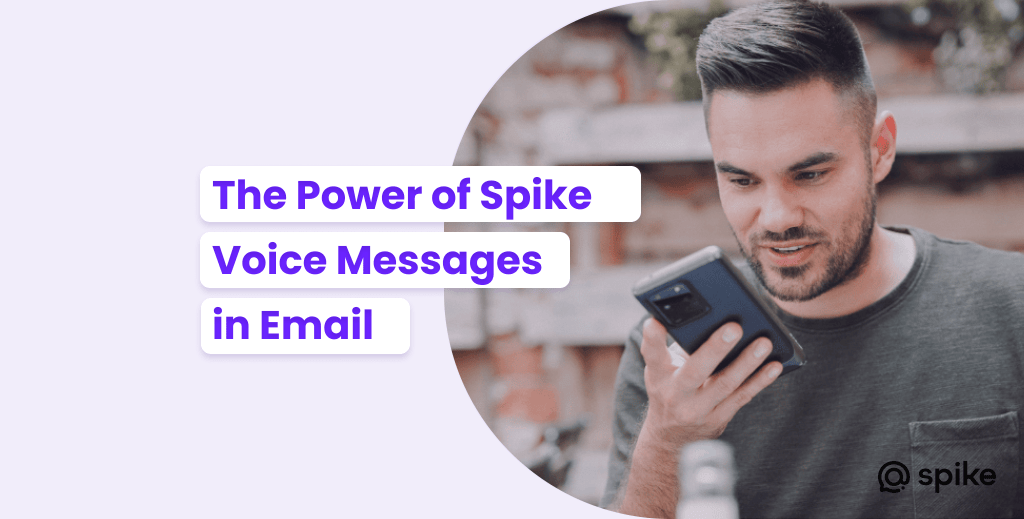The Power of Spike Voice Messages in Email

The integration of voice memos into daily communication, mainly through Apple’s iMessage, has significantly increased. This trend indicates a broader shift towards more immediate and personal forms of digital interaction at work. On average, people spend 80% to 90% of their time daily communicating with each other, and many individuals, often with AirPods or similar earbuds, find listening to voice messages convenient and a part of their daily routine. This familiarity with voice-based communication in personal contexts like iMessage paves the way for similar features in professional environments.
Spike’s voice messaging in emails taps into this trend, recognizing the comfort and ease of use that people have developed with voice memos. By adopting voice messages in email communication, Spike aims to bring a more personal, efficient, and accessible dimension to professional exchanges. This transition from text-based to voice-enabled communication is particularly timely in an era where remote work and digital interaction are increasingly the norm, offering a blend of convenience and personal touch that written emails often lack.
Benefits of Integrating Voice Messages into Email
Integrating voice messages into email, as seen with Spike’s innovative approach, offers several key benefits:
-
Time-Saving and Convenience
Voice messages streamline communication. They’re quicker to record than typing lengthy emails and can be listened to at the recipient’s convenience. This feature is handy for conveying complex ideas or instructions that might be cumbersome to type.
-
Enhanced Expressiveness and Clarity
Voice messages add a personal touch to digital communication. They convey tone, emotion, and emphasis, which text alone may not fully capture. This expressiveness can reduce misunderstandings and enhance the clarity of the message.
-
Accessibility for Diverse Users
Voice messaging opens up more avenues for accessibility. It’s beneficial for users who may find typing difficult or tedious, including those with certain disabilities or those not comfortable with written communication. Additionally, it supports diverse work environments where multitasking is typical, allowing users to listen to messages while engaged in other tasks.
In essence, voice messages in emails bridge the gap between the impersonal nature of text and the expressiveness of face-to-face communication, making them a valuable tool in modern professional communication.
How to Use Spike Voice Messages Effectively

Using Spike voice messages is straightforward. On mobile, you simply tap the microphone icon in a message to start recording. Once done, you can preview and send the voice message by tapping the blue checkmark. On the desktop app, click the (+) icon in the message compose window, select ‘Voice Message,’ and start recording. After recording, you can review and send the message as an audio file attachment. This intuitive process makes sending voice messages as easy as traditional text emails, enhancing your communication experience.
For detailed steps and images, visit Spike’s help page.
Tips and Tricks to Enhance Spike Voice Message Experience
-
•
Preparation
Outline your points before recording to stay on topic.
-
•
Quiet Environment
Choose a calm spot to minimize background noise.
-
•
Quality Microphone
Use a good microphone for clear audio. This could be a built-in microphone in a quality device or an external one for enhanced clarity.
-
•
Headphones with Microphone
Devices like AirPods can provide clear audio capture while allowing you to hear yourself.
-
•
Expressive Tone
Use a natural, conversational tone for better engagement.
-
•
Brevity is Key
Keep messages concise to respect the recipient’s time.
-
•
Review Before Sending
Listen to your recording to ensure clarity and correct any mistakes.
Impact on Remote Work and Team Collaboration
Voice messages present a unique middle ground in digital communication, blending elements from emails, texts, and calls. Here’s how they compare and excel:
-
•
Voice vs. Emails and Texts
Emails and texts are text-based and lack the personal touch and tone of voice. Voice messages, on the other hand, convey emotions and nuances, making communication more private and less prone to misinterpretation.
-
•
Efficiency
Unlike lengthy emails or texts, voice messages quickly record and convey more information in less time. They are particularly effective for explaining complex ideas or instructions that are cumbersome to type.
-
•
Situational Advantage
Voice messages are more effective when emotional nuance is important, like providing feedback or discussing sensitive topics. They are also advantageous when the sender is mobile or multi-tasking, where typing might be inconvenient.
-
•
Voice vs. Calls
Unlike phone calls, voice messages don’t require both parties to be available simultaneously. This asynchronous nature respects the recipient’s time and allows them to respond conveniently.
-
•
Clarity and Record Keeping
Voice messages offer the clarity of a phone call with the record-keeping advantage of an email. They can be saved and revisited for future reference, unlike phone calls.
-
•
Inclusivity and Accessibility
For people who find typing challenging or are not proficient in writing, voice messages provide an accessible alternative. They also cater to different learning and communication styles.
In summary, voice messages in email balance the immediacy of calls and the thoughtfulness of written messages, offering a versatile tool for various communication needs in a mobile-first world.
Voice Messages vs. Traditional Communication Methods
Integrating voice messages into digital communication offers a unique blend of the advantages of emails, texts, and calls while also addressing their limitations.
Personal Touch vs. Emails and Texts
Voice messages bring a personal touch absent in text-based emails and texts. They capture the nuances of tone and emotion, offering a richer, more humanized form of communication. This expressiveness helps to reduce misunderstandings and conveys messages more effectively, especially in emotional or sensitive contexts.
Efficiency and Clarity
Voice messages offer an efficient way to communicate complex ideas, which can be time-consuming and unclear when typed. They provide a quick, clear medium to share detailed instructions, explanations, or updates, saving valuable time and reducing the need for follow-up clarification.
Situational Superiority
In situations that require emotional depth or immediate feedback, voice messages excel over emails and texts. They are especially effective in remote working environments for brainstorming sessions, quick updates, and providing feedback, where the tone of voice and immediate conveyance of ideas are crucial.
Asynchronous Communication
Unlike phone calls, voice messages do not require simultaneous presence, offering the flexibility of asynchronous communication. This feature allows recipients to listen and respond conveniently, facilitating better time management and respecting personal schedules.
Comprehensive Communication
A Voice message blends the detail-oriented nature of emails, the immediacy of phone calls, and the convenience of texts. This makes them a comprehensive tool for communication, particularly in remote work scenarios where clarity and efficiency are paramount.
Accessibility and Inclusivity
They provide more accessible and inclusive communication, catering to individuals who may find typing challenging or prefer auditory learning. This feature makes digital communication more accessible to a diverse range of users.
Record-Keeping and Reference
Unlike phone calls, voice messages can be saved, archived, and referred to later, providing a reliable record of conversations. This aspect is beneficial for maintaining a clear explanation of decisions, instructions, or ideas shared in a professional setting.
Future of Voice Messaging in Professional Communication
The future will see voice messaging becoming more deeply integrated with various communication platforms. This integration will streamline workflows, making switching between text, voice, and other media easier. This flexibility will enhance productivity, particularly in remote and hybrid work environments, where diverse communication tools are essential.
AI technology will play a significant role in evolving voice messaging. We can anticipate features like advanced voice to text transcription, making voice messages easily searchable and more accessible. AI could also introduce intelligent analysis of voice messages, providing insights like sentiment analysis or automated summarization.
As these technologies mature, voice messaging is set to become a pivotal tool in professional communication. The blend of human touch and AI-driven efficiency will redefine how we communicate in professional settings, making voice messaging an alternative and a preferred mode of communication for many.
FAQ
Voice messages in emails offer a more personal touch, convey tone and emotion, save time compared to typing, and improve clarity and understanding in communication.
Voice messages combine the efficiency and record-keeping of emails with the expressiveness and immediacy of phone calls, without requiring simultaneous presence like calls do.
Can voice messages integrate with other digital communication tools?
Yes, voice messages can seamlessly integrate with various communication platforms, enhancing workflow flexibility and productivity, especially in remote and hybrid work environments.
Future advancements include AI-driven features like voice-to-text transcription, searchable voice messages, and smart analysis tools for insights like sentiment analysis.
Gain Communication Clarity with Spike
You may also like
Best Tools for Efficient Remote Working
Finding and implementing the best remote work tools is crucial to the success of remote and hybrid teams. Check out our top picks.
Read MoreHow to Find Unread Emails in Gmail, Outlook, & Spike
Discover how to find unread emails in Gmail, Outlook, and Spike. See why Spike offers the most user-friendly experience.
Read MoreHow to get Gmail on Desktop for Windows and Mac
Desktop apps typically offer faster performance, offline access, and an integrated user experience with the operating system
Read More



